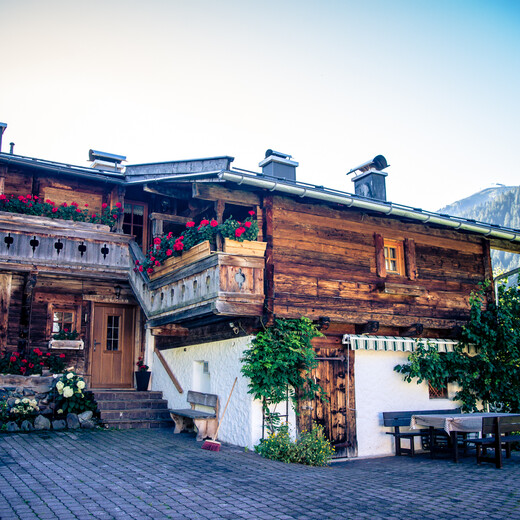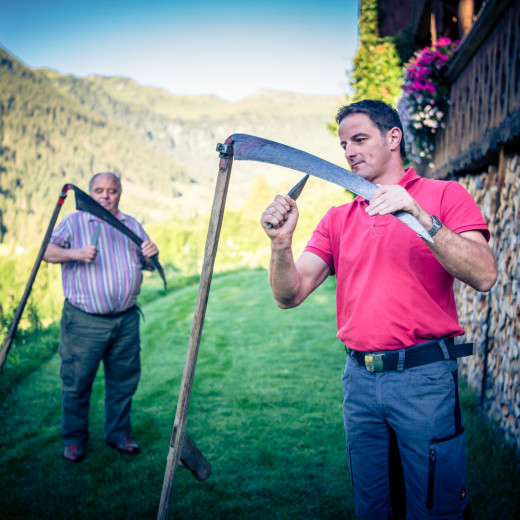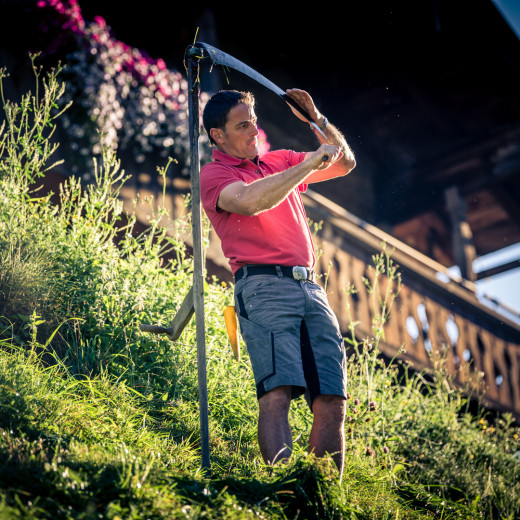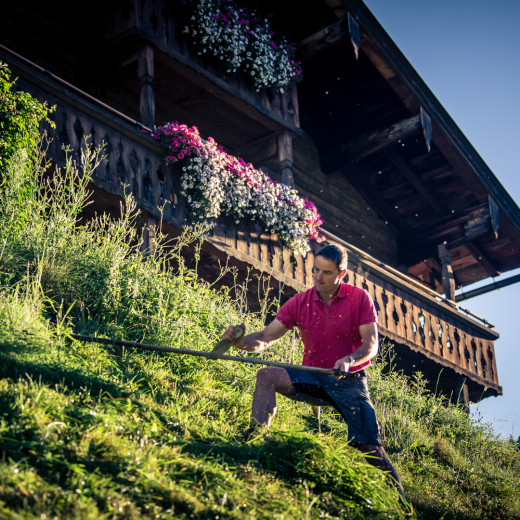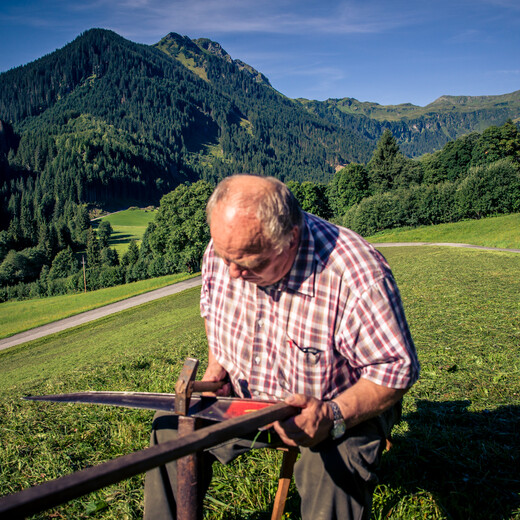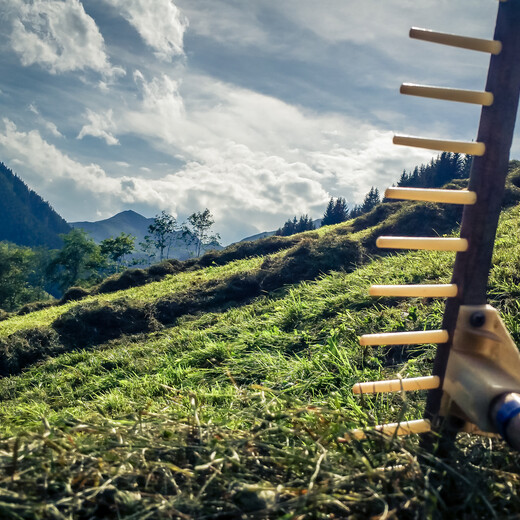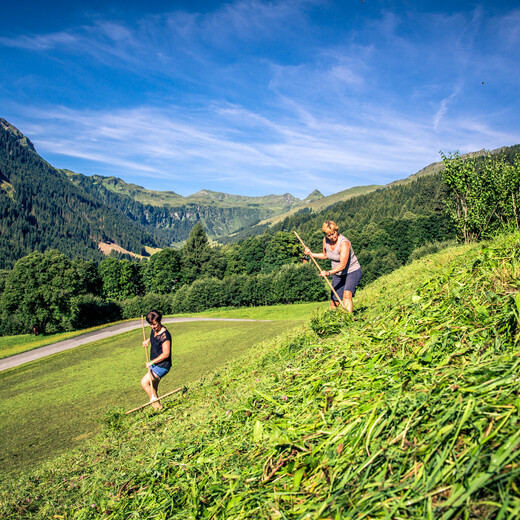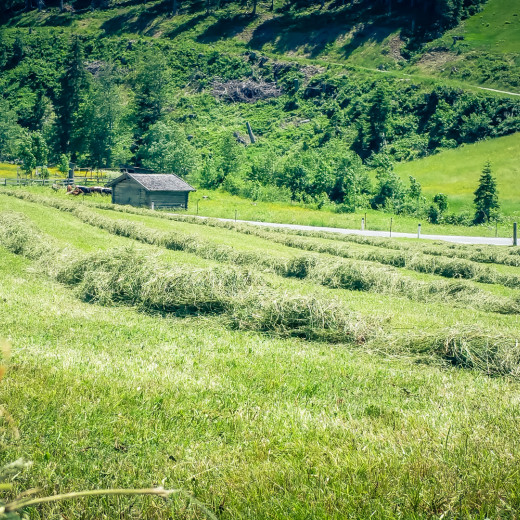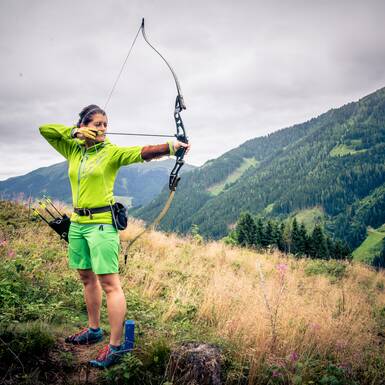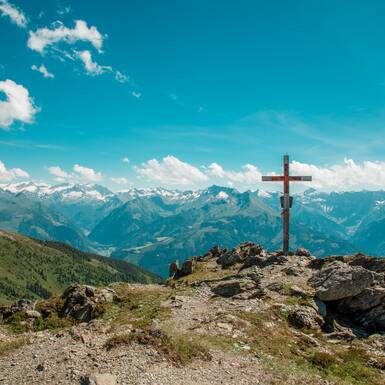- Traditions
Of mowing and raking
Nothing triggers childhood memories the way the scent of freshly cut hay does. During the summer heat, the hay, heaped into piles, dries up picturesquely by the green hillsides of the Glemmtal valley. On particularly steep mountainsides, you will still see the farmers working the hay harvest with their scythes and rakes. And when it comes to scything, especially the sharpening of the scythe blade, practice makes perfect. Only a perfectly sharpened blade enables you to cut the hay stalks with a single slice and minimal effort.
On two to three occasions during the summer, the farmers move out onto their mountain pastures and start cutting the juicy meadow grass with their cutter bars or their mowing tractors. In many places, the practice is still dominated by traditional methods of scythes and rakes. Saalabach Stories attended the final mowing session at the Maroldengut estate in Hinterglemm and learned a whole lot about the right time, the right kind of blade and the right weather that make for the perfect hay harvest.
Andrea and Michael Hasenauer, part-time farmers, together run the Mardoldengut estate, located in the beautiful valley head. ‘We keep mountain pasture oxen. Part of our livestock grazes here right next to the house, the other part on a mountain pasture located higher up. We administer 53 ha, 33 ha of which are forestland. 11.5 ha of the land needs to be mowed twice a year, the rest is left for the cattle. I am working full-time at the lift-company — a blessing for me as a farmer! My employer lets me take time off during the summer so that I can pursue my agricultural work. Once it’s time to start cutting, all we have to do is to wait for is the right weather, because then it’s finally time to the hit the meadows. We work with machines where possible, but from time to time we like to bring out the scythe’, Michael Hasenauer explains to me. ‘We mow rather late in the summer due to our elevation. This gives the herbs on the meadow time to seed and is good for biodiversity. The amount of hay is significantly bigger after the first cut in July, which we then bring into the barn. The second cut doesn’t yield quite as much. Once it’s time for the actual haymaking, we have to wait for the ideal weather conditions. Our own intuition helps here, but we also like to use the weather apps on our smart phones’, Andrea says and laughs, who, next to her agricultural work, also looks after three children and the holiday home. Once the time is right, the whole family comes together and mowing takes place for two days at the Maroldengut estate, as well as at the Rammerngut estate where their relatives are.
The ‘Blockleitn’
‘Bockleitn’ is what the residents of Pinzgau call a steep meadow hillside, and this absolutely applies to the Maroldengut estate. Alexander ‘Xandi’ Gensbichler arrives at the hillside with his freshly sharpened scythe early in the morning and with a perfect swing, he mows through the dewy grass. ‘We use the scythe to cut the wet grass, because it’s just easier to cut it this way’, reveals Michael, prior to positioning himself at the steep hillside and rhythmically slashing his scythe through the stalks. Every couple of minutes or so, the two farmers place their scythes upright, clean the cutting edge with some hay and work the scythe with a grindstone. This adds additional sharpness to the blade, but the so-called ‘Dengeln’ process of the scythe is much more important for a good cut. And few know how to do this as well as Xand Gensbichler can. In the video, he explains exactly what one needs to look out for while doing so.
Raking the hay
Now, the hay stays put until it’s dry. In the meantime, it’s turned and then brought together into symmetrical layers, called windrows, with the mowing truck or the hand rakes. ‘We don’t have to wait until they’re completely dry, because we’ve got a computer-operated dehydrator on our hayloft’, reveals Michael, demonstrating that technological process has also entered the more traditional forms of agriculture. ‘In general, we want to work the hay as little as possible because this increases the quality of the fodder. If it dries out completely on the field, the dry blossoms and leaves would crumble as we bring in the hay and only the fibre-rich stalks would remain for the livestock. As a result of the final dehydration on the hayloft, we don’t lose anything to crumbling, and all the energy-rich plant components remain intact’. Even the Hausenauer’s children come to the field to rake the hay. Cheeky little Lisa leads by example and manoeuvres the wooden rake like a pro - that she wears her traditional Dirndl dress while doing so is not common practice, but just a nice coincidence that we caught with the camera.
The mountain pasture oxen curiously watch us do our work and seem to be aware that the farmers are preparing their future fodder. They moo whenever Michael swings his scythe. ‘We keep the oxen for around three years and then sell their meat in farmer-to-consumer direct marketing. Local produce is something that’s very important to us and several good eateries in the valley cook with our Pinzgau beef. In order to create a good product and to keep the quality of the meat high, we have to work hard during the hay harvest to provide the best possible fodder. This was the last time we mowed this year, what grows back now is for our returnees from the mountain pasture. When they come back to the farm during autumn, they will find plenty of grass in front of the house’, says Michael Hasenauer, as he turns his focus back on his work and swings the sharp blade of his scythe through the grass.

